

injectablevitaminc.com/images/Ch28.pdf. Malathion-induced hepatotoxicity in rats: The effects of vitamins C and E. www.mv.helsinki.fi/home/hemila/CT/Eichbaum_1977.pdf. injectablevitaminc.com/images/Ch29.pdf. Vitamin C for preventing and treating tetanus - The Cochrane Library - Hemilä. Background Tetanus is a severe disease that can be prevented by vaccination.
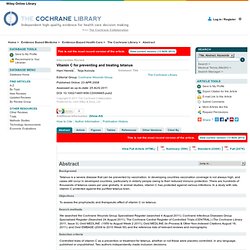
In developing countries vaccination coverage is not always high, and cases still occur in developed countries, particularly in elderly people owing to their reduced immuno protection. There are hundreds of thousands of tetanus cases per year globally. In animal studies, vitamin C has protected against various infections. In a study with rats, vitamin C protected against the purified tetanus toxin. Objectives To assess the prophylactic and therapeutic effect of vitamin C on tetanus. Search methods Selection criteria Controlled trials of vitamin C as a prevention or treatment for tetanus, whether or not these were placebo controlled, in any language, published or unpublished. Data collection and analysis Both review authors independently extracted data from trial reports and assessed methodological quality.
Main results. www.mv.helsinki.fi/home/hemila/CT/Dey_1966_ch.pdf. www.sinauer.com/media/wysiwyg/samples/nsp-immunity-9-3.pdf. www.vitaminc.co.nz/pdf/ENDOTOXIN-AND-VITAMIN-C.pdf. Endometrial damage and apoptosis in rats induced by dichlorvos and ameliorating effect of antioxidant Vitamins E and C. Cardiotoxicity in rats induced by methidathion and ameliorating effect of vitamins E and C. Turhan Yavuz Bekir Yildirim Ozden Candir Ahmet Corâ Nermin Karahan Ali Kutsal.

Carbofuran-induced toxicity in rats: Protective role of vitamin C. The effects of diazinon on pancreatic damage and ameliorating role of vitamin E and vitamin C. Abstract.
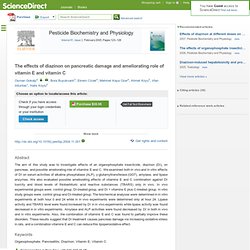
EVALUATION OF SUBCHRONIC CHLORPYRIFOS POISONING ON HEMATOLOGICAL AND SERUM BIOCHEMICAL CHANGES IN MICE AND PROTECTIVE EFFECT OF VITAMIN C. The effects of organophosphate insecticide methidathion on lipid peroxidation and anti-oxidant enzymes in rat erythrocytes: role of vitamins E and C. Effects of Vitamin C and E on PCB (Aroclor 1254) induced oxidative stress, androgen binding protein and lactate in rat Sertoli cells.
Abstract The effect of Aroclor 1254 and the ameliorative effect of Vitamin C and E on Sertoli cell function were studied in adult male rats.
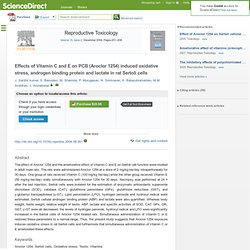
The rats were administered Aroclor 1254 at a dose of 2 mg/kg bw/day intraperitoneally for 30 days. One group of rats received Vitamin C (100 mg/kg bw/day) while the other group received Vitamin E (50 mg/kg bw/day) orally simultaneously with Aroclor 1254 for 30 days. Necropsy was performed at 24 h after the last injection. Sertoli cells were isolated for the estimation of enzymatic antioxidants superoxide dismutase (SOD), catalase (CAT), glutathione peroxidase (GPx), glutathione reductase (GST), and γ-glutamyl transpeptidase (γ-GT).
Keywords Aroclor 1254; Sertoli cells; Oxidative stress; Testis; Vitamins. Carbofuran-induced toxicity in rats: Protective role of vitamin C. In vivo changes in antioxidant systems and protective role of melatonin and a combination of vitamin C and vitamin E on oxidative damage in erythrocytes induced by chlorpyrifos-ethyl in rats. The effects of methidathion on lipid peroxidation and some liver enzymes: role of vitamins E and C. L-Ascorbate protects rat hepatocytes against sodium arsenite—induced cytotoxicity and oxidative damage. Tanmoy Rana Subhashree Das Diganta Pan Sumanta De Subrata Kumar Das.
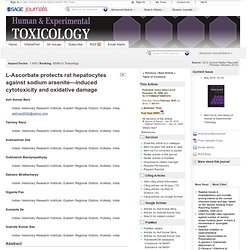
Studies on the Inactivation of Diphtheria Toxin by Vitamin C (I-Ascorbic Acid) The role of vitamin C as antioxidant in protection of oxidative stress induced by imidacloprid. Abstract Pesticides may induce oxidative stress leading to generate free radicals and alternate antioxidant or oxygen free radical scavenging enzyme system.
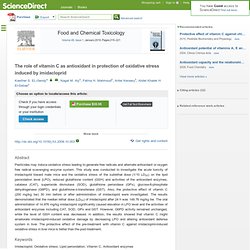
This study was conducted to investigate the acute toxicity of imidacloprid toward male mice and the oxidative stress of the sublethal dose (1/10 LD50) on the lipid peroxidation level (LPO), reduced glutathione content (GSH) and activities of the antioxidant enzymes; catalase (CAT), superoxide dismutase (SOD), glutathione peroxidase (GPx), glucose-6-phosphate dehydrogenase (G6PD), and glutathione-s-transferase (GST). Also, the protective effect of vitamin C (200 mg/kg bw) 30 min before or after administration of imidacloprid were investigated. The results demonstrated that the median lethal dose (LD50) of imidacloprid after 24 h was 149.76 mg/kg bw. The oral administration of 14.976 mg/kg imidacloprid significantly caused elevation in LPO level and the activities of antioxidant enzymes including CAT, SOD, GPx and GST. Keywords. Vitamin C and Tetanus in Animal Studies: a Systematic Review.
By Harri Hemilä Version May 29, 2012 Contents Introduction Tetanus is a disease caused by the toxin of Clostridium tetani, which may contaminate wound (see summaries eg.
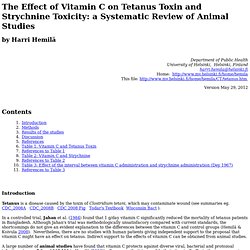
CDC_2008A CDC_2008B CDC 2008 Fig Todar's Textbook Wisconsin Bact ). www.mv.helsinki.fi/home/hemila/CT/Ghosh_1939_657.pdf. Protective effect of vitamin C against the et... [J Nutr Biochem. 2003. Treatment with vitamin C dissolves toxic protein aggregates in Alzheimer's disease. Researchers at Lund University have discovered a new function for vitamin C.
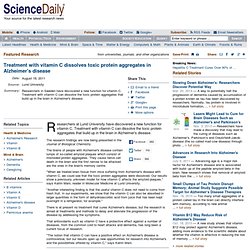
Treatment with vitamin C can dissolve the toxic protein aggregates that build up in the brain in Alzheimer's disease. The research findings are now being presented in the Journal of Biological Chemistry. The brains of people with Alzheimer's disease contain lumps of so-called amyloid plaques which consist of misfolded protein aggregates. They cause nerve cell death in the brain and the first nerves to be attacked are the ones in the brain's memory centre. "When we treated brain tissue from mice suffering from Alzheimer's disease with vitamin C, we could see that the toxic protein aggregates were dissolved. "Another interesting finding is that the useful vitamin C does not need to come from fresh fruit. There is at present no treatment that cures Alzheimer's disease, but the research is aimed at treatments and methods to delay and alleviate the progression of the disease by addressing the symptoms.
Vitamin C Antidote too all known toxins Thomas Levy, MD - even SNAKEBITE! VIRAL VIRUS BACTERIAL. Levy. Vitamin C, Infectious Diseases, and Toxins: Curing the Incurable, by Thomas E.
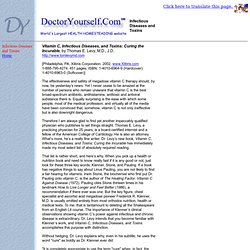
Levy, M.D., J.D. [: Xlibris Corporation. 2002. www.Xlibris.com 1-888-795-4274. 451 pages. ISBN: 1-4010-6964-9 (Hardcover); 1-4010-6963-0 (Softcover)] The effectiveness and safety of megadose vitamin C therapy should, by now, be yesterday’s news. Yet I never cease to be amazed at the number of persons who remain unaware that vitamin C is the best broad-spectrum antibiotic, antihistamine, antitoxic and antiviral substance there is. Therefore I am always glad to find yet another impeccably qualified physician who publishes to set things straight. That list is rather short, and here’s why. Without hedging, Dr. "It is completely appropriate to use the term "cure" when, in fact, the evidence demonstrates that a given medical condition has clearly and repeatedly been cured by a specific therapy. . . And this is precisely what Dr.
Knowing full well how the medical profession will react to such statements, Dr. Effect of vitamin C on plasma total antioxidant status in patients with paraquat intoxication.